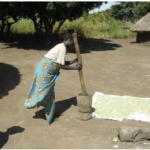


Kenya Agricultural and Livestock Research Organization
NARO-NaSARRI
Uganda and Kenya
11/2017—11/2019
Finger millet [Eleusine coracana (L.) Gaertn.] is an indigenous cereal grown by smallholder farmers in Kenya and Uganda. However, despite considerable progress in research and dissemination of improved technologies of finger millet in both countries over the last decade, farmers have not benefited as much as they could from the improved technologies. Soils in the region are of low fertility as a result of continuous cropping and inadequate soil fertility enhancements strategies. This has led to food and nutritional insecurity, and low incomes resulting in declining living standards.This project will engage with farmers to assess how they can use locally available inputs as efficiently and effectively as possible to enhance soil health for sustainable finger millet production in the region. Interventions to be assessed with farmers will include legume rotations or intercropping, application of small amounts of nitrogen and phosphorus fertilizers (micro-dosing), use of farm yard manure or poultry manure and any other nutrient inputs that farmers might have to test. These options will be evaluated, verified, demonstrated and disseminated in western Kenya and eastern Uganda, where the two principal researchers are based. Recognizing that farmers have the potential to set their production goals and to achieve them within their limits, and that adults learn best from their peers, the project will adopt a Farmer Research Network approach to diagnose production constraints and develop solutions in a participatory manner.
The project objective is to evaluate, verify, demonstrate, and disseminate integrated soil health management options for finger millet production under varying socio-ecological conditions in two counties in western Kenya and three districts in eastern Uganda. Finger millet-legume integration systems, rotation cycles, and other farmer-preferred soil health options will be tested for their effects on soil health and finger millet productivity. The options will be relevant to local contexts in terms of resource levels, social preference for food, income, and soil health improvement potential. Farmers will assess the productivity, profitability, and local viability of the options. Additionally, farmers will have a chance to assess and exchange local and improved finger millet germplasm. The project will adopt multi-disciplinary collaborative research and a farmer research network approach. To facilitate learning and knowledge sharing, farmers will be engaged throughout the research process (conceptualization, designing options based on contexts, implementation, results analysis and dissemination). Gender considerations will be explicitly examined. The expected outcomes will be improved soil fertility and health for sustainable finger millet and legume production. Additional expected benefits include mutual interactions and learning among and within farmer research networks in the region, improved nutritional status among farm families due to diet diversity, improved income generation from finger millet and legumes and diversified production systems that enhance multiple component interactions between farmers and the natural ecosystem.
Outputs
Outcomes
